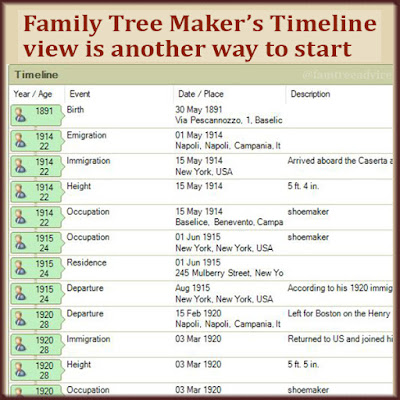Take another look at your family research goals for the year. What will you do differently with your 2019 goals?
I had the day off from work Monday. You know what that means, don't you?
Genealogy time!
I decided I would try to complete an item from my list of 2018 Genealogy Goals. That item was to "Fill in the 'Need to find' column on my document tracker." My document tracker is a spreadsheet noting each person with document images in my family tree.
There's a column for major items: birth, immigration, marriage, censuses, naturalization, death, and several more.
The last column is where I make note of which major documents are missing. If a person's census column contains 1910, 1920 and 1940, then the 1930 census belongs in the 'Need to find' column.
Since I was giving attention to all 1,686 lines in the spreadsheet, I thought it'd be a good time to get more detailed.
| Your family tree probably has a lot of identical and similar names, too. |
First, since so many people in my tree have the same name, I added their father's name in parentheses after their name: Lebrando, Alfred (son of Amedeo).
Second, I filled in everyone's birth year, followed by "cert." if I have an image of the birth certificate. I use the word certificate only for birth, marriage and death certificates. Everything else is a document.
Third, I put in other dates that I have reason to think are right, even though I have no document. Thinks about immigration. A census form will tell you someone's immigration year. But without the ship manifest, that's nothing more than a clue. When I do have the manifest, I enter "1909 (doc.)" for "document".
After a few hours (with plenty of interruptions), I completed this 2018 genealogy goal. For 2019, I'll set another reachable goal, like trying to find every missing census form in the 'Need to find' column.
The moment I finished this goal, I checked my list for what else I could do. I spent the rest of the day working on "Replace microfilm photos with digital document images". A few years ago, I had to view my Italian's ancestors' civil records on microfilm. Sometimes I photographed the microfilm viewer's surface as it projected a dark, blurry, awful image.
 |
| My next goal is to replace the poor-quality document images with good ones. |
Now the same microfilm is available online in gorgeous, sharp, bright, high resolution. My goal is to replace the dark iPhone images (about 200 of them) with the great images I've already downloaded to my computer.
And when I add the improved images to my family tree, I make sure they're noted in my document tracker.
Soon it'll be time to make my 2019 Genealogy Goals official.
Here's what I've learned about annual goals over the course of this year.
- Your goals should include grunt work. Choose tasks you need to do to make your research better. But make sure you have a good chance of finishing during the year. Filling out my document tracker was grunt work. And I finished it.
- Your goals should include projects with a definite ending. Last week I wrote a nice biography of my grandfather. I want to write more of them for about 10 of my ancestors. That's got a definite end. I know I can do that. Keep your projects to a manageable size.
- Your bigger goals should be broken into chunks. One of my goals for 2018 was to log the info from those thousands of downloaded Italian records into a spreadsheet. That's too big a goal. So next year I'll break off a chunk I think I can finish. Like, "Log all the birth records from Colle Sannita" (my grandfather's hometown).
- Save things you may not be able to finish in a year for your Genealogy To-Do List. One of my goals this year was "Find my parents' connection". DNA tells me they're about 4th cousins. I've been trying to find their connection, but nothing so far. That's not a good item for the goal list. It's leaving me feeling disappointed.
Here are 2 things I'd like you to think about now.
- What goal can you possibly finish in the next 6 weeks?
- What grunt work, tasks or chunks of a bigger project should you put on your list of 2019 Genealogy Goals?
Want to get more efficient so you can tackle those goals?




